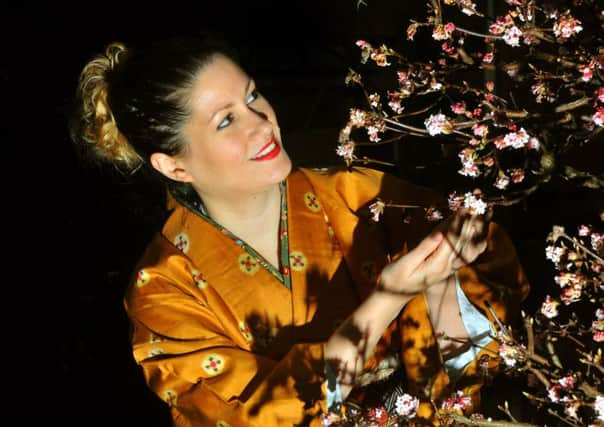The Yorkshire artist who is turning Japanese


He was right and Katie Chaplin is a good example of just how far a good book can take you. She regularly flies 6,000 miles from her home in Northallerton to Kyoto and it’s all thanks to Memoirs of a Geisha. She read the novel by Arthur Golden when she was 18 and became “totally obsessed” with Japanese culture.
“I loved the vivid descriptions, especially of the textiles. It made me want to go to Japan and become a geisha. Obviously, things didn’t quite turn out like that, but that book was what first got me hooked,” she says.
Advertisement
Hide AdAdvertisement
Hide AdShe finally touched down in the Land of the Rising Sun nine years later and is now an expert in the art of the kimono, has learnt the language and has become Britain’s biggest supplier of Japanese fabric.
“It’s no exaggeration to say that the book changed my life,” says Katie, whose own story took a few twists and turns before she found her happy ending.
She left university part way through a degree in History of Art unsure of which career path to take. At the age of 20, she gave birth to her daughter, Ebony, and keen to find work that she could fit around motherhood, she began silk-painting.
“Again that was all to do with my obsession with Japan. I painted Japanese ladies in a kimono inspired by ‘ukiyo-e’ woodblock prints. I sold the paintings and ran workshops. I’ve always loved art and crafts. I can remember asking for a roll of Sellotape for my birthday when I was little and I was thrilled when I got it,” says Katie.
Advertisement
Hide AdAdvertisement
Hide AdBy 2005 she had managed to save enough to take what she thought would be a one-off “trip of a lifetime” to Kyoto – the setting for Memoirs of a Geisha.
“It was amazing. It was like being in the book. I saw geisha in the streets, I saw them dancing, had tea with them and I did some craft workshops,” she says.
She came back with a suitcase full of washi paper – handmade from tree bark – and, enthused and invigorated by her visit, she came up with the idea for Japan Crafts.
Her one-woman enterprise began by selling craft kits and washi paper and offering workshops. Now fabrics form the bulk of her business.
Advertisement
Hide AdAdvertisement
Hide Ad“Japanese fabric is amazing. It is very high quality and very different from anything else. It is mostly based on traditional patterns that have been around for hundreds of years, like the interlocking circles which are considered lucky,” she explains.
She has just found a supplier who is happy to export fabrics to her but, until recently, Katie travelled to Japan four times a year to buy, cramming as much material as she could into suitcases and backpacks.
“It took a long time to build up contacts and find a supplier. I had to learn Japanese, which I did by using a CD and an online language school, but it has paid off.”
Her company is based at her cottage and her partner, Simon Gibson, recently gave up his job to join her in the business, which has doubled its turnover in the last year.
Advertisement
Hide AdAdvertisement
Hide AdWhat was the dining room is now a work room with shelves full of fabric and a cutting table, where the couple spend hours measuring the £10 a metre cloth to length for dressmakers and slicing it into squares for quilters.
“Quilting is massive and getting bigger and quilters love to find something different,” says Katie, who also uses the loft bedroom as a store room.
She has a busy online shop, sells at the biggest UK craft fairs and holds workshops. Her latest was at a Japanesecomic convention in America. These outings offer a good excuse to look the part and wear a traditional kimono. She now has over 80 and has had lessons in how to dress in them. It is a laborious process that requires contortions and a lot of patience.
It’s not just a robe, there are straps, ties, pads that flatten the figure and the decorative Obi belts backed with stiff plastic. It’s why most modern-day Japanese people wear a kimono only on special occasions.
Advertisement
Hide AdAdvertisement
Hide AdMost of Katie’s kimonos date from the 1950s and 60s and cost as little as £20, because, until recently, second-hand garments were a fashion faux pas. The very best new kimonos can cost tens of thousands of pounds.
“When I first wore a kimono my Japanese friends laughed and said I looked like their grandma but vintage is catching on.
“After lessons and a lot practice it now takes me half an hour to dress in one.
“They are very good for your posture because they make you stand straight,” says Katie, who has made many Japanese friends over the last ten years.
Advertisement
Hide AdAdvertisement
Hide AdHer new importing set-up now means she doesn’t have to make quite so many business trips, so instead she is planning a holiday. It’s in Japan, of course.
“I’ve been dozens of times now but I am planning a big trip for my 40th next year. I want to see more of the country.”
As for the book that sparked her oriental odyssey, nowadays it has to stay firmly on the shelf.
“I think there are a few cultural inaccuracies that I’d notice now and so I don’t want to read it again and destroy the magic,” she says.
• Japan Crafts, japancrafts.co.uk